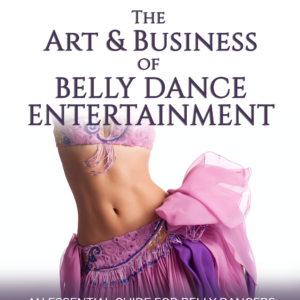Do you ever feel like you are aimlessly trying to become a better belly dancer, but you have no idea how to get from point A to B, much less all the way to Z?
Wouldn’t it be nice to have a clear step-by-step guide that tells you exactly how to go from being a new dancer to a professional quality performer?
Well, here you go… The Belly Dance Mastery Roadmap!
This guide is broken down into Beginner, Intermediate, and Advanced Skill Levels.
Each Skill Level is divided into these critical Skill Sets:
Musicality
Technique
Performance Skills
Practical Skills
*Other
Each Skill Set has:
An Objective – What you should be focusing on at each level
A Suggested Practice / Drill – An actionable item that you should be actively incorporating into every aspect of your personal practice, class, and performance time.
Two More Important Points:
- Getting good at anything takes a lot of practice, even under the best conditions. Choosing to practice at home during the beginner or intermediate phase or only coming to one class a week will not cut it, you must get as much quality, focused, targeted practice as possible to see consistent improvements in your performances. (Thanks to Lori Hegarty who reminded me to include this reminder!)
- As you work through this roadmap, it’s very important to spend adequate time at each Skill Level. Don’t move on until you have truly mastered that level. Remember, dance is like the game “Jenga,” the fewer blocks you have in the lowest layers, the more unstable the whole structure is. You definitely want to build the strongest foundation you can, fully committing to each level before going on to the next.
Would you like personalized help with your dance journey?
Let’s talk about your dreams and create a strategy to make it happen!
Email us today to talk about it
| Skill Set | Objective | Suggested Practice / Drill |
BEGINNER | ||
| Musicality | ||
| Identify the tempo of the music | Begin to feel the beat | |
| Learning Choreographies / Intro to Improv | The dancer learns how others “hear” the music and put individual movements and steps together through the practice of choreography. The dancer is learning the fundamental movements and begins to casually chain steps/movements together, just having fun with the new style they are beginning to assimilate. | |
| Be able to hear large changes in the music, for example from verse to chorus | Listen to appropriate belly dance music as often as you can to familiarize yourself | |
| Be able to hear ornamental/accent sounds in music. | Listen to appropriate belly dance music as often as you can to familiarize yourself | |
| Technique | ||
| Posture | Practice maintaining correct dance posture with an “intention forward” and “energized” appearance, not “relaxed” back | |
| Gain control of upper extremities: arms and hands | Practice and perform “placing arms and hands in space.” Focus on maintaining strict arm and hand positions, until it becomes natural. Arms and hands should never be allowed to distract. | |
| Continue to acquire a strong technical foundation. | Keep practicing the basics and only dabble with more difficult techniques. Practice at home and continue to attend classes to keep your technique clean. Be sure to follow through with each movement completely, Never cutting short your movements. | |
| Learn to flow from one footwork pattern into another with ease | Practice drill foot patterns: 1) individually 2) chained together, until smooth | |
| Begin layering upper body movements over footwork | Practice by drilling each movement 1) individually 2) layered over footwork, until harmonious | |
| Learn Stage Directions | During practice, be aware of your body’s direction and position on stage. Mind your spatial awareness by maintaining an appropriate distance from other dancers | |
| Performance Skills | ||
| Intro to Expression | Gain control of your face by keeping a smile on your face during practice/performance Dancing = acting. Get used to the awkward feeling until it becomes natural | |
| Relaxation & Breathing | Be sure to breathe steadily without holding the breath during practice and performance. Keeping a calm mind. | |
| Intro to Emotive Energy Generation | Begin to practice generating positive feelings in the mind/body, for example, excitement, anticipation, fun, and happiness. | |
| Intro to Physical Energetic Nuance | Begin to notice and practice how you can control the “energy” of your movements, Hard vs. soft, Fast vs. slow, External vs Internal | |
| Focus: Sightline Awareness | Begin to hold the head up, eyes looking outward toward or just above the audience. Gets comfortable with eye contact. The dancer begins to “connect” with the audience. | |
| Practical Skills | ||
| Getting Comfortable on Stage | The dancer might be cautiously apprehensive to deathly afraid. This stage is meant to expose the dancer to the rigors of performance and to help desensitize any dancers with an unhealthy amount of anxiety. | |
| Pre-Performance Preparation | The dancer will be introduced to pre-performance ritual to focus the mind and relax you before going on stage. | |
| Rehearsal Strategies: Effectively Preparing for Performances | Drill: Movements > Steps > Combos > Small Sections > Large Sections > Whole Choreography | |
| Understand what an appropriate beginning student costume is and isn’t | Learn what is appropriate for belly dance at the beginner level and what NOT to wear. Learn what accessories are appropriate for our style | |
| Understand appropriate hair and make-up requirements | Hair must be different from day look and look “done” Make-up must be beyond “evening look” and the dancer must understand why we need make-up to compensate for lighting/distance conditions | |
| Understand the need for preserving the belly dancer’s mystique | Have a cover-up for all performances | |
| Intro to Intros & Exits | Dancers learn the purpose of intros and exits. Learn basic entrance protocols. How to bow and exit protocols. Intro to poses. | |
| Other | ||
| Remove Any Obvious Distractions | Dancers might move an area of the body too much, like unusual facial/mouth movements or flipping hands. These will need to be immediately trained out of the dancer. | |
INTERMEDIATE | ||
| Musicality | ||
| Counting / Rhythm / Phrasing | Dancer is able to identify individual measures, longer phrases, and is able to count musically (1+2+3+4+) and “dancer style” (…5,6,7,8). Rhythm identification happens here. Style exploration begins here. | |
| Improved Timing | Dancer is able to remain in good timing and execute movements when the music asks for it. Transitions are controlled, not too fast or too slow. | |
| Choreography Creation / More Improvisation | The inspired dancer begins to create their own combinations or short choreographies. The dancer is more confident in the fundamental movements and improvising with some freedom within the vocabulary. This is the time to train both modalities. | |
| Intro to Timbre | Dancer is becoming aware of how the different Middle Eastern instrument’s sound and where they tend to resonate in the human body. | |
| Intro to Energetic Nuance | The dancer begins to sense and respond to subtle changes and the qualities of what they are hearing in the music. | |
| Technique | ||
| Improved / Good Technique | More complex technique is more easily assimilated because the dancer has a strong foundation. Dancer is gaining more control of movements and layers are becoming cleaner. Things are getting interesting! | |
| Improved Transitions | Movements and steps are more seamless and executed with little to no hesitation. Arms begin to flow smoothly from position to position. Movements are complete, not cut short. | |
| Gain better control of lower extremities: legs and feet | Precise position and placement. Legs are well controlled. Footwork is definite. Feet are in a pleasant position. Legs and feet add polish to your performance. | |
| Blocking / Good Use of Stage | Dancer is more aware of the space they have on stage, can maintain precise positions, adjust pattern size when appropriate, and know where they are going directionally in more complex dances. | |
| Intro to Intentional Movement | The dancer begins to imbue their movements with intention, purpose, fullness, and boldness. Movements feel and look “full of energy”, not lazy or executed with little/low effort. | |
| Performance Skills | ||
| Improved Expression | Gain greater control of face by beginning to express more dramatic emotions. The dancer should be able to easily hold a smile and is beginning to dabble in showing more emotional range. | |
| Improved Emotive Energy Generation | Dancer continues to play with generating and expressing feeling. Here the dancer explores darker, more dramatic feelings and how to demonstrate those feelings through movement. | |
| Intro to Stylistic Nuance | Dancer is gaining a greater sense of different styles and will begin to get a better handle on performing within each style’s unique requirements. | |
| Improved Physical Energetic Nuance | Dancer is gaining a greater sense of the music and begins exploring how to express the subtleties of what they are hearing. | |
| Focus: Sightline: Internal | Dancer is able to maintain upward/outward sightline easily and looks confident. Head can be held up and eyes out toward the audience. Here the dancer begins to explore more emotions. They will explore directing focus inward to express their internal world to the audience. The dancer begins to interact with the audience. | |
| Practical Skills | ||
| Learning to Trust Yourself: “I can do this” | Dancer is discovering what they are capable of. Experience is gained. The dancer begins to realize the artist can do no wrong and the audience is not a harsh critic, but a supportive partner in the experience. Gains a more realistic perspective to lay the groundwork to break through to the next level. | |
| Improved costume | Dancer upgrades from student to semi-pro grade costumes. From simple tops, skirts, dresses to lower-medium end decorated bra/belts/skirts/dresses. Experiments with different types of costumes to find what looks best on them. Plays with accessories. | |
| Improved hair | More dramatic, ornamented. Dancer is finding a “performance hairstyle” that works best for them and the look they want to present. | |
| Improved make-up | The dancer becomes bolder with make-up and begins to understand the usefulness of makeup. Dancer feels less awkward about wearing the correct amount. Dancer is experimenting, finding their best look. | |
| Discovering Your Performance Rehearsal “Sweet Spot” | The dancer begins to discover how much preparation they need to do well in performance. | |
| More on Intros & Exits | The dancer learns more intro and exit options. The dancer starts learning when the best time to enter is, in relation, to the music and when to make an exit. Exit music is suggested. Find your best poses. | |
ADVANCED | ||
| Musicality | ||
| Deeper Musical Appreciation | The dancer can identify the rhythms and differentiate among musical styles. | |
| Good Timing | Dancer is on the beat and flows well with what is going on in the music. | |
| Good Stylistic Nuance | Dancer is a chameleon, knows their music styles and can dance accordingly. Not a “one trick pony” that uses the same style/moves for everything. | |
| Master of Choreography and Improvisation | The dancer can dance a choreography with fresh emotion as if they were improvising, and can improvise with creativity and balance as if everything was planned. The dancer might have situational preferences, but they can do both well when required. | |
| Good Energetic Nuance | The dancer can hear and respond quickly to what is going on in the music with accuracy and ease. | |
| Technique | ||
| Excellent Technique / Technical Variety | All movements and steps are executed with complete control and clarity. The dancer knows how to adjust each movement to the qualities of the music. One size doesn’t fit all! | |
| Seamless Transitions | All movements and steps flow effortlessly with no short cuts in movements. No awkward pauses or unnatural pathways. | |
| Complete Extremity Control | Legs, feet, arms, hands are used well to support emotional content and add polish to the performance. | |
| Excellent Use of Stage / Space | The dancer knows how to use space and can fill the stage area appropriately. Not neglecting areas or tending to gravitate to one position. Understands that positions and patterns carry meaning and can be used accordingly. | |
| Performance Skills | ||
| Excellent Expression | The dancer has complete control of emotive faculties of the face/body The dancer can express whatever they feel in the music with authenticity and projection | |
| Excellent Intentional Movement | All movements appear to be done with purpose. Nothing is executed lackadaisically. | |
| Focus: Multi-point / Naturalness | The dancer seems “natural” and is able to shift focus effortlessly among all points. Dancer always knows “where” to look and the audience feels as if there is interaction (and connection) between them and the dancer. | |
| Practical | ||
| Developing the Diva Mindset: Freedom, Power, and Charisma | The dancer comes into and embraces their own power. They are confident they can handle any situation on stage with grace and are not afraid of failure. They fully realize perfection is an illusion, so they are completely free to be whom and what they are on stage with no apology. | |
| Adv Intros & Exits | The dancer knows how to make the absolute most of all of their stage time. They hit the stage at precisely the right moment to build the most anticipation or drama. They end with a bang, leaving the audience wanting an encore. Nails the pose. | |
| Best Dressed | Everything is perfect, from accessories to costume details. Fits well and compliments body, style, and movements. Their costume is high-end and well made, and glamorous. | |
| Picture Perfect Hair & Makeup | Dancer understands how to use both hair and make-up to make the most of their own physical features. Uses hair and make-up as an integral part of their artistic vision. | |
Copyright 2019 © Anna Lisa Schkade-Siytangco | Ahlam Academy
Share "Mastering Belly Dance: Beginner - Advanced"
-
Anna
Beginning Your Journey
Lifetime accessBeginner12 lessons0 quizzes159 studentsStarting any new adventure can be intimidating. Wouldn't you like someone with lots of experience…Free






